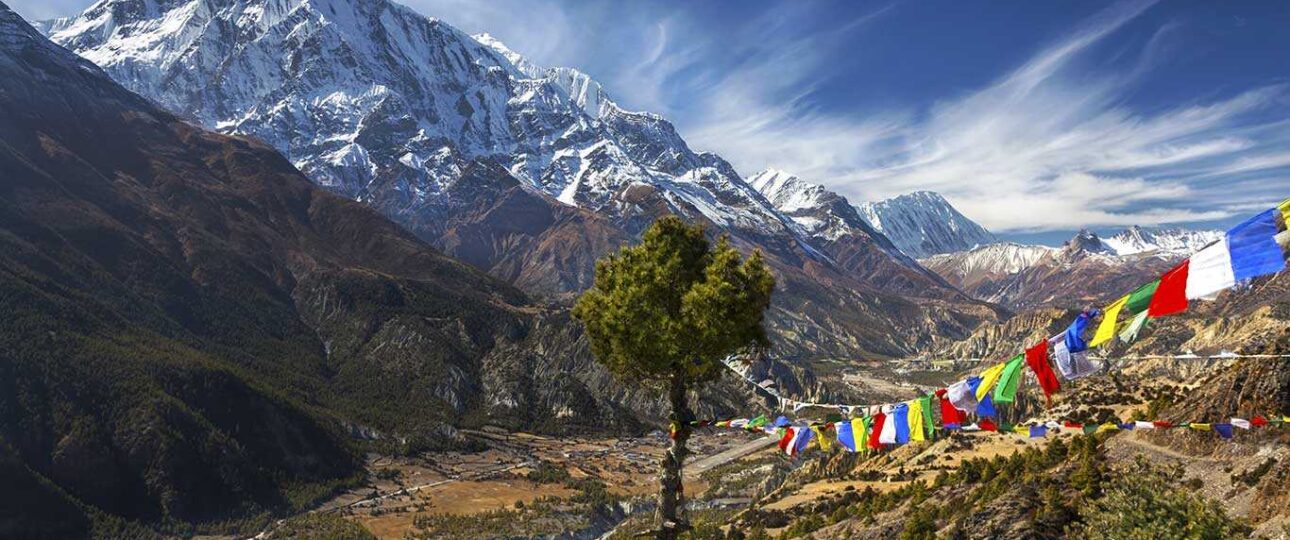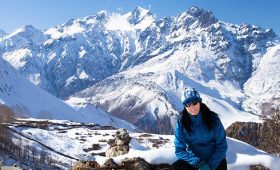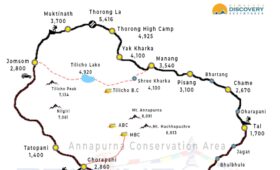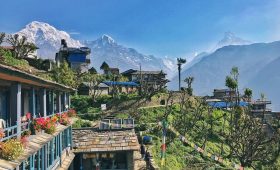The Annapurna Circuit Trek provides an unforgettable experience with its rich natural resources, cultural landmarks, and friendly locals. To make the most of this trek, considering factors such as the time of year, budget, physical/mental preparation, and essential gear plays a vital role.
Spring or Autumn are considered one of the best times to embark on the Annapurna Circuit Trek. With May falling under the peak trekking season of Spring, it is also an ideal time for this trek. This month also offers excellent weather and stable conditions with clear navigation routes, enhancing the overall journey.
In May, you can explore the vibrant environment of the Annapurna region, including the Annapurna Conservation Area. Also, you can enjoy breathtaking views of Mount Annapurna, Machhapuchhre, Dhaulagiri, and Himchuli against clear skies. The Buddhist culture along the Annapurna Circuit trails adds to the experience with its harmonious and hospitable atmosphere.
Here are some of the details that you should know before embarking on the Annapurna Circuit Trek. Let’s explore them in detail:
Highlights of Annapurna Circuit Trek in May
- 360 views of the Himalayas like Annapurna, Dhaulagiri, Machhapuchhre, Himchuli, and many others.
- Reach one of the high altitude passes, Thorong La Pass, at 5,416 meters above sea level.
- Explore the beautiful towns of Jomsom And Muktinath.
- Explore the cultural diversity and religious values in Muktinath.
- Explore Tibetan Monasteries in Manang and Braga Village.
- Encounter endangered animals like Snow Leopard, Red Panda, Himalayan Tahr, and others in Annapurna Conservation Area
Planning Your Annapurna Circuit Trek in May
To ensure a successful Annapurna Circuit Trek in May, trekkers must attend preparatory sessions covering route information, weather conditions, physical and technical requirements, and cost details. These sessions provide essential knowledge for a safe and enjoyable trek.
Understanding the Route
The Annapurna Circuit Trek spans from Kathmandu to BesiSahar, leading through notable landmarks like Thorong La Pass, Muktinath, Jomsom, and Manang. Familiarizing oneself with the trekking route is crucial for a seamless journey through this picturesque trail.
Here is the list of your day-to-day destinations in the Annapurna Circuit Trek:
- Arrive in Kathmandu
- Drive to Besisahar by hiace van & drive to Chame
- Trek to Pisang
- Trek to Manang
- Acclimatization day & Discover Manang
- Trek to Yak Kharka
- Trek to Thorong Phedi
- Trek to Muktinath (3800m) via Thorong La Pass (5416m)
- Trek to Jomsom
- Fly to Pokhara and Fly to Kathmandu on the same day
- Fly to home
Chame lies 2,650 meters above sea level, and as trekkers hike uphill in the elevation, the altitude gradually changes. Pisang sits at 3,250 meters, while Manang and Thorong La Pass are 3,519 meters and 5,416 meters above sea level. Here acclimatization is very important. Trekkers will go through the acclimatization process in Manang, which allows you to adjust to the existing altitude.
Physical Preparation
The Annapurna Circuit Trek presents a moderately challenging terrain, demanding robust physical fitness from trekkers due to its rugged and remote landscapes. The daily trek spans approximately 6 to 7 hours on average, necessitating a high level of physical strength, stamina, endurance, and energy. Prior trekking experience, exposure to altitude, altitude training, and other relevant physical exercises are strongly recommended for those undertaking this trek.
Trekkers embarking on the Annapurna Circuit should be well-prepared for the demanding journey, with a focus on developing and maintaining the necessary fitness levels to navigate the challenging terrain and sustain the daily extended hikes.
Booking and Permits
Selecting a reliable trekking agency is crucial for those planning the Annapurna Circuit Trek in May. Himalaya Discovery provides both standard and customizable packages, ensuring they cater to the specific needs of each trekker.
Additionally, it is essential to arrange flights and logistics in advance due to the peak trekking season in May. As Spring attracts a surge in trekkers, securing accommodations and services becomes challenging without prior arrangements.
Besides, trekkers must obtain two trekking permits; Annapurna Conservation Area Entry Permit and TIMS (Trekkers’ Information Management System) to embark on this journey. Annapurna Circuit lies in the protected land area of Annapurna Conservation Area. So to get through the region, trekkers must purchase this license. It costs NRs. 3000 per person for the international trekkers. If you are a trekker from SAARC Nations, you can get it at NRs. 1000 per person, while Nepalese trekkers have the privilege of a price tag with only NRs. 100 per person.
Similarly, to obtain a TIMS Card, you must pay NRs. 2000 per person. You can get these permits from the Tourism Board of Nepal in Kamaladi, Kathmandu.
Weather and Climate in May
For a successful Annapurna Circuit Trek in May, it’s crucial to consider the prevailing weather conditions. May marks the peak trekking season in Nepal, offering an ideal environment for a fulfilling journey with optimal conditions to appreciate the region’s scenic beauty.
During May, the weather is generally pleasant, characterized by clear blue skies and lower precipitation compared to other seasons. The humidity is minimal, and the likelihood of fog and cloud accumulation is low. These conditions provide trekkers with clear visibility, allowing for a spectacular view of prominent peaks such as Mount Annapurna, Dhaulagiri, Himchuli, and others.
Temperature During Annapurna Circuit Trek in May
In May, the Annapurna Circuit Trek experiences moderate temperatures, with daytime being warmer than nighttime. Temperature variations depend on the altitude. In BesiSahar, May temperatures range from 15°C to 31°C, while Manang sees a minimum of 15°C and a maximum of 30°C. Jomsom experiences temperatures between 15°C and 31°C during this month.
Pros of Trekking in May
Favorable Weather:
In May, the Annapurna Circuit Trek offers optimal weather with clear skies, minimal rainfall, and mild temperatures. The spring season reaches its peak, providing stunning natural views as surroundings clear out. May brings favorable conditions for an enjoyable trekking experience.
Stunning Spring Scenery:
Spring season has its taste and color in Nepal, and when you embark on this trek, you can have experiences with all these. The vibrant sceneries of the green and colorful forests in the trail with the stunning views of the snow-capped mountains in the north are breathtaking and are the best opportunity for photography geeks.
High Visibility:
In May, the Annapurna Region experiences minimal rainfall, resulting in low humidity and virtually no fog or clouds obstructing the panoramic vistas. Trekkers can enjoy clear blue skies, offering optimal visibility to appreciate the awe-inspiring scenery, including the majestic peaks of the Mahalangur Annapurna Range, the Thorong La Pass, and the verdant forests nestled within deep gorges and valleys.
Moderate Temperatures:
In May, the Annapurna Region has mild temperatures without extreme heat or cold. Daytime is cool with gentle sunlight, but it’s advisable to use sunblock. Nights can be chilly, so pack a sleeping bag, pads, and warm clothing for better comfort.
Cons of Trekking in May:
High Altitude Crowds:
May marks the peak season for trekking the Annapurna Circuit, resulting in a notably higher number of trekkers. Historical trail data for May indicates it as one of the busiest months of the year. The trail becomes congested, posing challenges for trekkers to navigate easily, especially at viewpoints. Popular locations like Jomsom, Manang, and Muktinath experience considerably higher foot traffic compared to other times.
Limited Availability of Tea Houses:
The increased trail congestion in May also leads to a downside of limited logistical options. Trekkers may encounter minimal access to tea houses for accommodation or may need to share living spaces, bathrooms, and other amenities with fellow trekkers. Coping with these circumstances may prove challenging for trekkers during this period.
Hiring Porters and Guides
Hiring guides and porters is crucial for the Annapurna Circuit Trek in May. Guides are mandatory for trekking in any Nepalese region, ensuring safety and assistance. The Nepal Government and Tourism Board require professional guides for trekking to remote destinations, focusing on trekkers’ safety. Guides aid in navigation, provide support, and assist in emergencies, facilitating communication with locals. Guide costs range from $30 to $50 per day.
Porters play a vital role by carrying backpacks (20-25 kg) during the trek. This allows trekkers to enjoy the beauty of the Annapurna Region without the burden of heavy loads. Porters can be hired for $20 to $30, depending on experience and service level.
Conclusion
Overall, Annapurna Circuit Trek in May is the best time to embark on this beautiful and adventurous journey. With several plus addons and advantages of the weather and climate condition, your journey to the Annapurna Region will be worthwhile for sure. If you are looking to embark on this journey, make sure you contact us for the full-fledged facilitation. We will be more than happy to help you with our customized trip packages at an affordable price.
Do you have any question about trip to Nepal?
Tell us about your trip to Nepal and what you expect from it. We will answer your questions in 24 hours and help you design a trip with a comfortable itinerary to best meet your needs.





